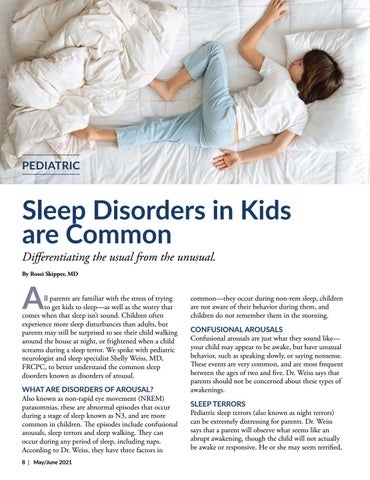PEDIATRIC
Sleep Disorders in Kids are Common Differentiating the usual from the unusual. By Rosei Skipper, MD
A
ll parents are familiar with the stress of trying to get kids to sleep—as well as the worry that comes when that sleep isn’t sound. Children often experience more sleep disturbances than adults, but parents may still be surprised to see their child walking around the house at night, or frightened when a child screams during a sleep terror. We spoke with pediatric neurologist and sleep specialist Shelly Weiss, MD, FRCPC, to better understand the common sleep disorders known as disorders of arousal. WHAT ARE DISORDERS OF AROUSAL? Also known as non-rapid eye movement (NREM) parasomnias, these are abnormal episodes that occur during a stage of sleep known as N3, and are more common in children. The episodes include confusional arousals, sleep terrors and sleep walking. They can occur during any period of sleep, including naps. According to Dr. Weiss, they have three factors in 8 | May/June 2021
common—they occur during non-rem sleep, children are not aware of their behavior during them, and children do not remember them in the morning. CONFUSIONAL AROUSALS Confusional arousals are just what they sound like— your child may appear to be awake, but have unusual behavior, such as speaking slowly, or saying nonsense. These events are very common, and are most frequent between the ages of two and five. Dr. Weiss says that parents should not be concerned about these types of awakenings. SLEEP TERRORS Pediatric sleep terrors (also known as night terrors) can be extremely distressing for parents. Dr. Weiss says that a parent will observe what seems like an abrupt awakening, though the child will not actually be awake or responsive. He or she may seem terrified,












